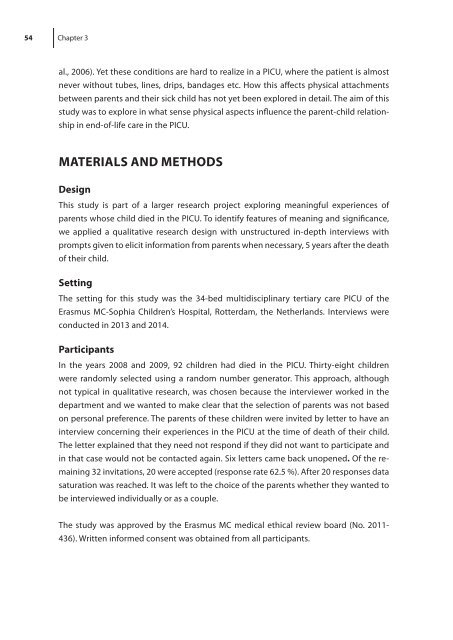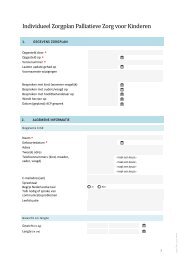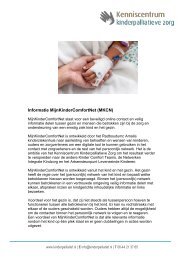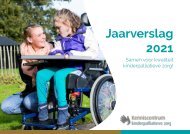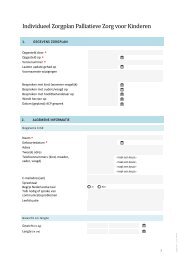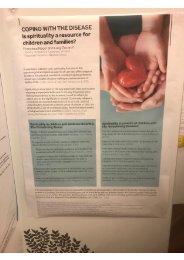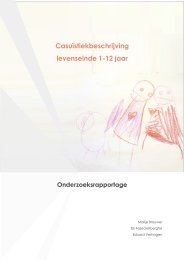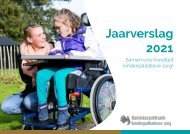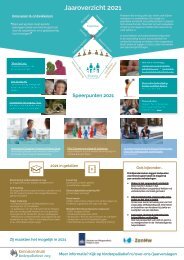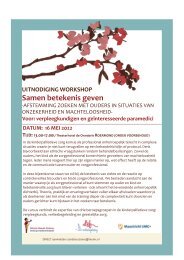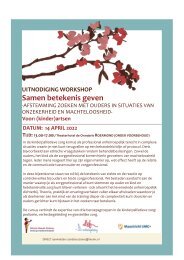Unveiling a fragile spirituality: Experiences of connectedness in pediatric palliative care
Create successful ePaper yourself
Turn your PDF publications into a flip-book with our unique Google optimized e-Paper software.
54 Chapter 3<br />
al., 2006). Yet these conditions are hard to realize <strong>in</strong> a PICU, where the patient is almost<br />
never without tubes, l<strong>in</strong>es, drips, bandages etc. How this affects physical attachments<br />
between parents and their sick child has not yet been explored <strong>in</strong> detail. The aim <strong>of</strong> this<br />
study was to explore <strong>in</strong> what sense physical aspects <strong>in</strong>fluence the parent-child relationship<br />
<strong>in</strong> end-<strong>of</strong>-life <strong>care</strong> <strong>in</strong> the PICU.<br />
MATERIALS AND METHODS<br />
Design<br />
This study is part <strong>of</strong> a larger research project explor<strong>in</strong>g mean<strong>in</strong>gful experiences <strong>of</strong><br />
parents whose child died <strong>in</strong> the PICU. To identify features <strong>of</strong> mean<strong>in</strong>g and significance,<br />
we applied a qualitative research design with unstructured <strong>in</strong>-depth <strong>in</strong>terviews with<br />
prompts given to elicit <strong>in</strong>formation from parents when necessary, 5 years after the death<br />
<strong>of</strong> their child.<br />
Sett<strong>in</strong>g<br />
The sett<strong>in</strong>g for this study was the 34-bed multidiscipl<strong>in</strong>ary tertiary <strong>care</strong> PICU <strong>of</strong> the<br />
Erasmus MC-Sophia Children’s Hospital, Rotterdam, the Netherlands. Interviews were<br />
conducted <strong>in</strong> 2013 and 2014.<br />
Participants<br />
In the years 2008 and 2009, 92 children had died <strong>in</strong> the PICU. Thirty-eight children<br />
were randomly selected us<strong>in</strong>g a random number generator. This approach, although<br />
not typical <strong>in</strong> qualitative research, was chosen because the <strong>in</strong>terviewer worked <strong>in</strong> the<br />
department and we wanted to make clear that the selection <strong>of</strong> parents was not based<br />
on personal preference. The parents <strong>of</strong> these children were <strong>in</strong>vited by letter to have an<br />
<strong>in</strong>terview concern<strong>in</strong>g their experiences <strong>in</strong> the PICU at the time <strong>of</strong> death <strong>of</strong> their child.<br />
The letter expla<strong>in</strong>ed that they need not respond if they did not want to participate and<br />
<strong>in</strong> that case would not be contacted aga<strong>in</strong>. Six letters came back unopened. Of the rema<strong>in</strong><strong>in</strong>g<br />
32 <strong>in</strong>vitations, 20 were accepted (response rate 62.5 %). After 20 responses data<br />
saturation was reached. It was left to the choice <strong>of</strong> the parents whether they wanted to<br />
be <strong>in</strong>terviewed <strong>in</strong>dividually or as a couple.<br />
The study was approved by the Erasmus MC medical ethical review board (No. 2011-<br />
436). Written <strong>in</strong>formed consent was obta<strong>in</strong>ed from all participants.


